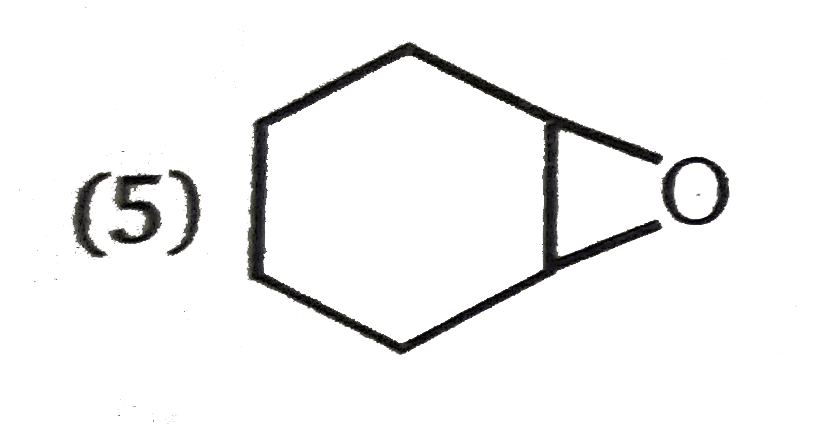A1.O3−−−−−−→2.Zn,H2O(CH3)2CO+HCHO+CHO∣∣∣CHO Thus A is :
(CH3)2CHCH=CHCH=CH2
(CH3)2C=CH−CH=CH2
CH3CH=CH−CH=OH−CH=CH2
None of these
To determine the original compound A that leads to the products (CH₃)₂CO (acetone), HCHO (formaldehyde), and CHO (aldehyde) upon undergoing reductive ozonolysis, we can follow these steps:
Step 1: Understand the Reaction
The reaction involves reductive ozonolysis, which is a reaction of alkenes with ozone (O₃) followed by a reduction with zinc (Zn) and water (H₂O). This process cleaves the double bond of the alkene and forms carbonyl compounds.
Step 2: Identify the Products
The products given are:
1. (CH₃)₂CO (acetone)
2. HCHO (formaldehyde)
3. CHO (an aldehyde)
Step 3: Analyze the Products
From the products, we can deduce that:
- Acetone has a carbonyl group (C=O) and two methyl groups (CH₃).
- Formaldehyde is a simple aldehyde with one carbon.
- The other CHO group suggests another aldehyde.
Step 4: Construct the Original Alkene
To generate these products through ozonolysis, we need to think about how the double bond in the original alkene could be positioned. The carbonyl groups in the products suggest that the original alkene likely had two substituents that could lead to the formation of acetone and two aldehydes.
Step 5: Formulate the Alkene
Assuming the original alkene is symmetrical, we can propose that it is 2-butene (CH₃-CH=CH-CH₃). Upon ozonolysis, this would yield:
- One molecule of acetone from the central carbon bond.
- Two molecules of formaldehyde from the terminal carbon bonds.
Step 6: Verify the Reaction
When 2-butene reacts with ozone, it forms an ozonide intermediate. Upon reduction with Zn and H₂O, this ozonide will yield:
- Acetone (from the central carbon),
- Formaldehyde (from the terminal carbon).
Conclusion
Thus, the original compound A is 2-butene (CH₃-CH=CH-CH₃).
---
The reaction involves reductive ozonolysis, which is a reaction of alkenes with ozone (O₃) followed by a reduction with zinc (Zn) and water (H₂O). This process cleaves the double bond of the alkene and forms carbonyl compounds.
The products given are:
1. (CH₃)₂CO (acetone)
2. HCHO (formaldehyde)
3. CHO (an aldehyde)
From the products, we can deduce that:
- Acetone has a carbonyl group (C=O) and two methyl groups (CH₃).
- Formaldehyde is a simple aldehyde with one carbon.
- The other CHO group suggests another aldehyde.
To generate these products through ozonolysis, we need to think about how the double bond in the original alkene could be positioned. The carbonyl groups in the products suggest that the original alkene likely had two substituents that could lead to the formation of acetone and two aldehydes.
Assuming the original alkene is symmetrical, we can propose that it is 2-butene (CH₃-CH=CH-CH₃). Upon ozonolysis, this would yield:
- One molecule of acetone from the central carbon bond.
- Two molecules of formaldehyde from the terminal carbon bonds.
When 2-butene reacts with ozone, it forms an ozonide intermediate. Upon reduction with Zn and H₂O, this ozonide will yield:
- Acetone (from the central carbon),
- Formaldehyde (from the terminal carbon).
Thus, the original compound A is 2-butene (CH₃-CH=CH-CH₃).
Similar Questions
Write the product of following reactions :
(a) CH3−H3C∣C=CH3∣C−CH3O3−−−−−→Zn/H2O , (b) CH3−C≡C−CH3O3−−−−−→Zn/H2O
( c) CH3−C≡C−CH3O3/H2O2−−−−−→ , (d) CH3−CH3∣C=CH−CH3O3/H2O2−−−−−→
View SolutionWrite correct order of acidic strength of following compounds:
(a)CH3−CH2−C∣FH−O∣∣C−O−H
(b)CH3−C∣FH−CH2−O∣∣C−O−H
(c)C∣FH2−CH2−CH2−O∣∣C−O−H
View Solution
Knowledge Check
Which of the following reactions will yield 2-propanol ?
1)CH2=CH−CH3+H2OH+−−→
(2) CH3CHOCH3MgI−−−−→H3O+
(3)HCHOC2H5MgI−−−−−→H3O+
(4) CH3COCH3CH3MgI−−−−→H3O+A1 and 2B2 and 3C3 and 1D2 and 4AK2Cr2O7−−−−−→dil.H2SO4BCH3MgI−−−−→H2OCH3−CH3∣C∣OH−CH3
The reactant A is ________.ACH3CHOHCH3BCH3COCH3CC2H5OHDCH3COOHWhich of the following compounds are not oxidized by HIO4 ?
(1) CH3−CH−OH∣ CH2−OH (2) CH3−C=0 ∣ H−C=O
(3) CH3−C=O ∣CH3−C=O (4) CH3−C=O ∣ CH3−CH−NH2
(5) (6) CH2−OCH3| CH2−OH (7) O∣∣ C−OH∣ CH2−OHA5,6,7B4,5,6,7C6,7D3,4,5,6,7
(6) CH2−OCH3| CH2−OH (7) O∣∣ C−OH∣ CH2−OHA5,6,7B4,5,6,7C6,7D3,4,5,6,7
A(C4H6)H2,Li−−−→1moleB(C4H8)1.O3−−−−−→2H2O/ZnCH3CHO Thus A and B are :
View SolutionIn the reaction ,
CH3CHO+HCN→AH+−−−−−→H2OB
The product B is ?
View Solution(CH3)3C−OH+(O)Oxidation−−−−−−−→−H2O−CO2A+(O)OxidationB−H2O−CO2 . The organic compound B is :
View SolutionAK2Cr2O7−−−−−−−→dil.H2SO4BCH3MgI−−−−−−−→H2OCH3−CH3∣C∣OH−CH3
The reactant A is :
View SolutionCH3CHO+HCHODil.NaOH−−−−−−−−→heatAHCN−−−−−→H3OB
The structure of compound B is
View Solution
